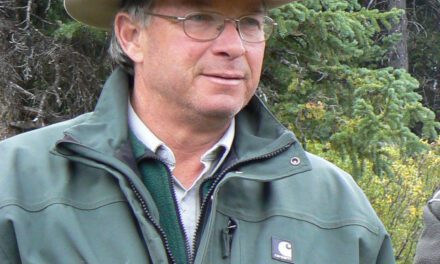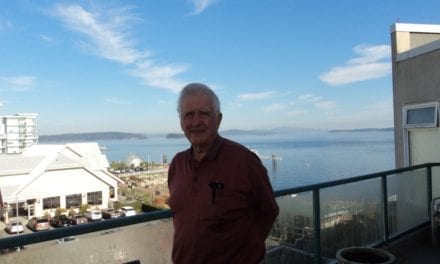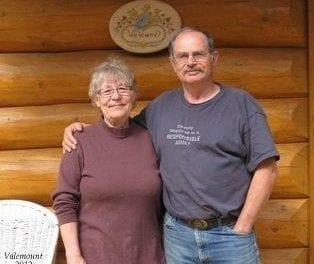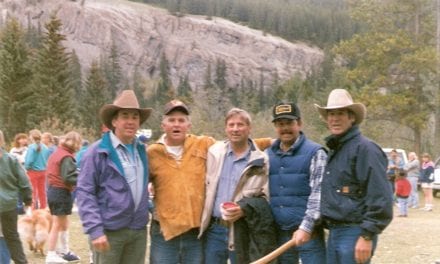Rod Wallace: I’ve seen Ya Ha Tinda Ranch Manager, Rick Smith, buying horses at the Innisfail horse sales. As you say it is pretty hard to buy a bombproof horse.
Rob: If a horse is really a good one, it won’t be at the horse sale.
Rob: The price of horses has risen dramatically in recent years. The Innisfail Bull Sale (Parsonage Bull Sale) recently had well broke ranch gelding that were averaging $11,200 (One sold for $17,500). So when you are buying a $2,000 one that somebody is trying to get rid of you don’t know what you are getting, nor do you know the background on that horse. A lot of horses are just not handled properly. The horse business has always had a lot of “experts” so it is kind of a risky business when it comes to buying horses at a horse sale. As it is now we can make our own mistakes; we don’t need help. (laughs)
Rod Wallace: Did you buy any horses at Innisfail that Ron Warner was selling?
Rob: No, we never did buy any of Ron’s horses. I worked for Ron for 8 years, and Rick (Smith) worked for him as well, but any horses that outfitters are selling are not suitable. If they don’t want them, we sure don’t either.
We want to have the horses last a long time. Tom McKenzie, the other Ya Ha Tinda ranch hand, and I take a lot of pride in our horse training, and we put a lot of blood, sweat and tears into their training. We want the horses well trained. The better the horses are, the better the riders are. We reject a lot of horses that aren’t suitable. The problem is that the skill level is not there with the people who are to use the horses so a lot of care must be taken. The parks’ staff do very well with the horses. These days there are a lot of seasonal staff and they don’t stick around long so there is always new staff needing to learn to use the horses. By the time they are competent riders they move on to something else.
Marie: Do you ride the colts for a year or more before they are sent to the parks?
Rob: We keep them for a longer period of time. We keep the horses until they are older and more mature. Like the scientists say, the horses are not totally physically and mentally mature until they are seven years old so that is why we keep them longer. We are trying to keep them now until they are least 5. I’d like to keep them longer than that but I don’t know about the feasibility of that. Once they are on the ranch, cost wise, it is not that expensive to feed a horse any more. The elk population has dropped to the point now where the grass on the ranch ranch can support the horses better. At one time there was 2000 head of elk on the ranch.
Marie: When we were there, it was the very dry years. There was just not that much grass. The wet years have certainly made a difference.
Rob: We’ve changed some feed programs too. We went to a pelleted feed for several reasons and one of the reasons is economics. Pelleted feed is cheaper because of the amount you need to feed. Ecologically speaking, pellets do not produce weeds because the pellets are cooked to a temperature that the weed seeds won’t germinate so they are weed-free. The pellets are specially formulated for nutrition and so if the grass is a little marginal, supplementing with the pellets will supply the nutrition that the horses need. It is working out quite well.
Rod Wallace: When you first started did you have several hundred head of park horses?
Rob: Well, when I first got hired there were roughly 150 head and now there are about 60 park horses.
At this point Rob’s wife Sue joined the interview.
Rod Wallace: You mentioned that you worked with Fred Dixon. Did you work for him?
Rob: I didn’t really work for Fred. Fred and Ann were in Riding Mountain for many years and they lived at the next warden station near us; about a 20 minute drive away. The Dixons were our closest neighbours and we spent a lot of time together anyways, socializing and visiting. Fred was into horse shows in his spare time. Fred would come over to our place and ride my horses and I would go to their place and ride his horses. So he gave me a lot of pointers and told me stories of the Ya Ha Tinda and the horses. Fred was my hero and still is. And so it was kind of neat to follow in his footsteps a little bit with me being at the ranch. I quite often think of him almost on a daily basis.
Rod Wallace: I just recently looked at Ann Dixons’s photo album of the photos of their days at the (Ya Ha Tinda) Ranch. Ann took quite a few pictures which is kind of nice as there is not a lot of other photos of the working activities from the ranch during those days. They had lots of packing experiences. There was another fellow that worked with Fred packing lumber into the parks. To me, it was quite a phenomenal endeavor to pack dimensional lumber of all lengths on horses.
Rob – Fred was kind of a magician around horses as far as I was concerned. I have met some pretty famous horse people but he fits the same category as Buck Brannaman (Buck Brannaman is a highly respected and skilled horse trainer and clinician from Wyoming. Buck has gained notoriety in his approach to handling horses and with horse owners due to his understanding of the mind of a horse, and the interaction of horses and humans. He conducts inspirational clinics and has produced videos and books.).
Rod Wallace: I think he was kind of an early “horse whisperer” kind of guy. He wasn’t called that or anything like it but it was his ability with horses. He seems to transmit the easier, gentler way of dealing with horses.
Rob: Yes, he was. I learned from Fred that you don’t stop learning about horses.
Rod Wallace: We have been joined by Rob’s wife Sue. Sue, we’d like to get your impression of living at the ranch.
Sue: Well the first time I heard that we were going to the ranch, I said to Rob, “What exactly am I going to do there?” But it didn’t take long until I found lots to do. Although, it was difficult going from a big house in Banff to the little tiny house at the ranch. (Rob & Sue moved into the tiny two-bedroom bungalow that originally was a Carrot Creek bungalow that had been moved to the ranch in the 1960s. Cal Hayes lived in this house and it was affectionately called “Cal’s House”.) We were in what is known as Cal’s house that had just had renovations and there was complete white linoleum on the floors which was hard to deal with. Especially with a small child, a large dog and a cat. The floor was never clean. It was hard to go to the little house. But we loved it out there. Both winter and summer. I rode, so I’d take Shelby on the horse and ride with Marie.
Rod Wallace: Did you have many bear problems?
Rob: I didn’t have too many incidents. I remember one time I’d gone for coffee and we had this bear that had been coming around the yard (getting into one of the burn barrels). (Household garbage was burnt on a regular basis as we did not have garbage handing facilities). What I didn’t know was the firing pin on Johnny’s old shotgun was a bit wore out. I got lined up on this bear and pulled one trigger and it went “click” – nothing happened. It was an old double-barreled shotgun loaded with rubber bullets. So then I pulled the other trigger and the same thing happened. So then I re-cocked it and I pulled both triggers and the gun went “boom!” and it hit the bear in the butt pretty good – he didn’t come back.
Sue: My sister, from Winnipeg, was visiting us and she could not believe what Rob was doing.
Rob: There was an incident when we had Dr. Michael Wilson from Pioneer Veterinary Service up to the ranch to castrate the colts. We always branded them at the same time so that we could tranquilize them in order to make it as easy as possible on all the young colts that were to be branded and castrated. Dr. Wilson was from South Africa and he said he really wanted to see a grizzly bear. We teased him that if he spent enough time here he’d likely see one. Minutes later, this young grizzly bear came up over the bank off Scalp Creek and meandered up the driveway and past the Quonset barn. The vet was so excited to see this bear. He kind of forgot about the task at hand for a short while.
Sue – I think the bear in the pasture feeding on a carcass was the most interesting. The bear would come in the early mornings and evenings to feed. Two wolves showed up and the one wolf would try to eat and the bear would chase it. Then, the other wolf would sneak in and eat while the bear was distracted. These two wolves kept that up for about an hour or two – distracting the grizzly so that they could sneak in to eat on the carcass.
Rob: Yeah, there’s been some funny incidents out there.
Rod Wallace – I hear that a fellow actually landed aircraft there.
Rob: That was pretty interesting as this plane came buzzing over the buildings and it was obvious he wanted to get down. He landed in the small pasture just south of the buildings, along the ranch road. Johnny jumped in his truck and I got in my truck and roared down there to where he had landed the plane amongst a few head of horses. The pilot, it turned out, was some sort of shirt-tail relative of Johnny’s, although he did not know that until after they got acquainted. He sort of dropped in for a visit so to speak (laughing). The Pilot had come from Golden, B.C. on a return flight to Olds-Didsbury Airport via Lake Louise, and the Red Deer River, a route he was familiar with. He got trapped under cloud cover and had no choice but to do a precautionary landing. Marie was on the Satellite phone with Banff dispatch in the event there might be a crash. The pasture he landed in is quite rough but he was skilled and managed to land it. Johnny and I roped off the plane as the horses were eyeing it up for an item to chew on. (laughs)
There was another incident the first year I was at the ranch. It was the May long weekend. I saw this plane go over the ranch yard about 4 or 5 pm flying awful low and I wondered why it was so low. At about 2 am there was a knock at our door and it was an R.C.M.P. officer and he told me a small plane had gone down in this area and so they wanted to set up a communications tower as they were looking for this plane. As it turned out, it had crashed on the mountain above the ranch yard. The pilot and passenger were both killed. They couldn’t find the wreckage for quite a while. The local R.C.M.P and the Sundre Search & Rescue guys were all out there come daylight trying to find it. At that time we still had the XJ radio telephone system, and this presented a problem security wise as they weren’t allowed to do certain communications without using a landline. So they were trying to run their own communications tower that they’d set up and they couldn’t get much coverage. They had me liaise with their headquarters and such on the XJ phone we had but they would not give me any information that would help to pinpoint the location of the crash. So I got a R.C.M.P. officer to speak to them but they still would not get much information out of the authorities. At that particular time, it was the peak of the war in Bosnia and the signals were scrambled on most of the satellites for whatever reason. Although the black box from the plane was giving off a signal, the signal indicated the crash was on the wrong mountain. Finally, the military from Cold Lake had called to tell the authorities exactly where the crash site was and that there was no urgency in getting to the site. The military had actually parachuted in to the site and had confirmed the status. They had air lifted the two fatalities out of the site. It was quite an unfortunate event.
Rod Wallace: Yes indeed. Can you tell us a little bit about the elk population fluctuations?
Rob: Well, pretty much ever since I’ve been there at the ranch there’s been on-going wildlife studies. Cliff White started all or most of the studies and is still involved in the project to bring back to the bison to the park. The population of elk was really high and I was amazed when I used to ride through there in the summer time with Ron Warner’s outfit. I guess they always thought that they’d never run out of grass on that place but the elk grazed it off like the greens on a golf course. So, we had to feed the horses and things like that, and it looked like the plains of the Serengeti at times.
Rod Wallace: So we are talking several thousand elk?
Rob: Yes, they estimated that between 1500 and 2000 depending on the winter. And then as the studies went on it was determined that what had happened was that a lot of the elk that usually migrated into the park had stopped migrating there, so there was 600-800 head that never left the ranch in the summer time. So they had the grass grazed off and so therefore something had to be done to encourage the elk to migrate once again. They started looking at different ways of doing this and one of the things was that the University of Alberta, working in conjunction with Cliff White, hired a U of A. student to take on the project. He was Holger Spaedke, a fellow from Germany, who was working on his Master’s Degree and eventually his Ph.D. The project was averse conditioning (hazing) of the elk to encourage the elk to move off of the ranch in the summer months. Holger asked me how I would do it and I suggested that it could be done on horseback. Holger had to train with me to learn to ride horses and haze the elk. The program used volunteer students to assist with the process, which involved going out every morning and trying to gently herd the elk to the west towards the park boundary. It became quite an interesting deal. The hazing of the elk was very beneficial to the horses as well because the horses got used to herding the elk and became accustomed to cross the river and creeks and to travel on various terrains on the ranch. That was a good project. We didn’t have much success, but at any rate it was an interesting thing.
Then the population of elk started to drop. Cliff White predicted that the ranch could handle about 300 head of elk in the wintertime. The interesting thing is that about the last 6 years that is basically the number we have observed on the ranch. It seems to be quite balanced, the grass is better. Some of the other animals have come back in stronger numbers – like the mule deer and a lot of white tail deer – way more than we used to have. There seems to be hundreds of deer there now. (Nelllie Murphy wrote In her unpublished memoirs that in the winter of 1942 they observed 150 head of deer in the pastures.) A lot of people think the elk died off. I don’t think that they did; I think that they have just moved elsewhere. There has been a lot of logging in the province that has created new habitat for the elk. The other thing that is interesting to me when I drive out to the ranch Monday mornings at this time of year, is that I’ll see the wild horses a lot more. The population is expanding. It is a lot heavier than what the government horse population is out of the ranch. I noticed that the elk seem to follow the wild horses around and whenever I run into wild horses I also run into elk. They seem to have a symbiotic relationship and there seems to be more elk where the wild horses range.




Recent Comments